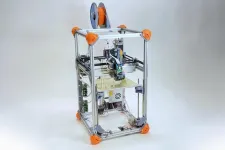(Press-News.org)
As telehealth visits become more prevalent, physicians can sometimes struggle to help patients effectively demonstrate a musculoskeletal exam through a screen.
At the University of Michigan Health C.S. Mott Children's Hospital, one physician found a way to help pediatric patients demonstrate different joint movements using a Barbie doll.
While on telehealth appointments with patients, Alecia Daunter, M.D., an assistant professor of pediatric rehabilitation medicine at U-M Health, found that verbally explaining how she wanted her patients to move their bodies was often challenging, sometimes leading to poorer quality visits and frustration. To try something new, she grabbed a Barbie doll off her desk and began to demonstrate what she wanted to see from the patient on the doll.
The findings were published in PM&R: The journal of injury, function and rehabilitation.
“The Barbie I use comes with a wheelchair and can bend at almost all of her joints. She’s an ideal model to help show my patients how I need them to move, flex, or extend their joints,” said Daunter.
“As I found this increasingly helpful with my own patients, some of my colleagues suggested that I should study this method to potentially share it with other physicians.”
Virtual world
Daunter and her lead co-author Alyssa Cook, M.D., a physical medicine and rehabilitation resident at U-M Health, had two groups of children between the ages of four and 17 years old -- totaling 30 children and their parents -- participate in the research via Zoom meetings.
Cook used a prewritten script to take the control group children and parents through a series of physical exam maneuvers without the Barbie doll. The second group heard the same script while Cook used the Barbie doll to demonstrate the movements that the physicians wanted to see.
Impact on visits, understanding
Afterward, Daunter and co-author Britney Papp, D.O., a former pediatric physical medicine and rehabilitation fellow at U-M Health, analyzed each video to determine the time to complete the entire examination, ensure each maneuver was completed correctly, and count the number of times participants needed verbal corrections to complete each step.
“Without the Barbie doll, the patients, parents and I sometimes became frustrated when it was difficult to understand what should be demonstrated, although we always finished the session,” said Cook.
“When the Barbie doll was used, the patients had a better understanding of what they needed to demonstrate, and I found it easier to explain what we were looking for. This is something I have also found true in my daily clinical practice.”
In a survey given to participants after the video call was conducted, all participants from the group with the Barbie doll felt that their experience was enhanced, and it was easier to understand what the physician was looking for.
For the physicians, the Barbie doll didn’t make the appointment shorter but also didn’t add any time to the appointment. The participants who had the benefit of the Barbie doll required less verbal prompting to successfully complete the examination.
Not just Barbie
Cook and Daunter encourage other healthcare professionals to use some form of visual aid when asking patients of any age to demonstrate movement during a virtual appointment.
“It doesn’t necessarily have to be a Barbie doll. Other action figures or small wooden artist mannequins will have the same effect. You just need to make sure the doll has joints that can move in a way that demonstrates what is being examined,” said Daunter.
“As telehealth becomes more prevalent, we need to adapt to make sure our patients are still receiving quality care and are at ease during their appointments.”
Additional authors: Claire Kalpakjian, Ph.D.
Funding: The authors received no financial support for the research, authorship, and/or publication of this article. Funding for participant incentives and purchasing the visual aid was provided by the Christopher Family SOAR Foundation.
Citation: “Visual Aid for Pediatric Virtual Musculoskeletal Exams: A Barbie Girl in a Telehealth World,” PM&R: The journal of injury, function and rehabilitation. DOI: 10.1002/pmrj.13167
Sign up for Health Lab newsletters today. Get medical tips from top experts and learn about new scientific discoveries every week by subscribing to Health Lab’s two newsletters, Health & Wellness and Research & Innovation.
Sign up for the Health Lab Podcast: Add us on Spotify, Apple Podcasts or wherever you get you listen to your favorite shows
END
Half of all patients discharged from hospital after a heart attack are treated with beta-blockers unnecessarily. This is according to a new study published in the New England Journal of Medicine. "I am convinced that this will influence future practice", says Tomas Jernberg, Professor at Karolinska Institutet and lead researcher of the study.
Today, when patients are discharged from hospitals after an acute heart attack, they are regularly treated with beta-blocker drugs such as metoprolol and bisoprolol. Now new research shows that about half of them do not benefit from the treatment and should not receive it at all. ...
Save the Date for the 15th World Mitochondria Society Annua Meeting on October 29-31, 2024, at DoubleTree by Hilton Berlin Ku’damm, Berlin, Germany. The WMS is pleased to announce the participation of two distinguished keynote speakers for the Targeting Mitochondria 2024 conference in Berlin this October.
Keynote Speaker of Day 1: Prof. Eric Schon
Professor Eric Schon from Columbia University, USA will deliver a presentation titled "Mitochondria in Alzheimer disease: it's not what you think".
Prof. Schon challenges the conventional understanding ...
ABSTRACT CT013
SAN DIEGO ― Combining the KRAS G12C inhibitor adagrasib with the anti-EGFR antibody cetuximab demonstrated promising anti-tumor effects in patients with KRAS G12C-mutated metastatic colorectal cancer (CRC), according to pooled results from the Phase I/II KRYSTAL-1 trial reported by researchers from The University of Texas MD Anderson Cancer Center.
The findings were presented today in a plenary session at the American Association for Cancer Research (AACR) Annual Meeting 2024 by Scott Kopetz, M.D., Ph.D., professor of Gastrointestinal ...
ABSTRACT CT014
SAN DIEGO – The first-in-class PARP1-selective inhibitor saruparib demonstrated encouraging early efficacy and a favorable safety profile in patients with homologous recombination repair (HRR)-deficient breast cancers, according to results from the Phase I/II PETRA trial led by researchers at The University of Texas MD Anderson Cancer Center.
Results from the first-in-human trial were presented today at the American Association for Cancer Research (AACR) Annual Meeting 2024 by Timothy Yap, M.B.B.S., Ph.D., professor ...
LOS ANGELES — Researchers with City of Hope®, one of the largest cancer research and treatment organizations in the United States, will present more than 70 abstracts and sessions on innovative clinical trial results, breakthrough diagnostic techniques and advances in treatment options as well as share their expertise on molecular profiling and the microbiome at the AACR Annual Meeting, which started April 5 and ends April 10 in San Diego.
In addition to City of Hope’s robust data being presented throughout the meeting, John D. Carpten, Ph.D., the Irell & Manella Cancer Center Director’s ...
SAN DIEGO – A combination of the KRASG12C inhibitor adagrasib (Krazati) and the anti-epidermal growth factor receptor (EGFR) antibody cetuximab (Erbitux) showed clinical activity and promising survival outcomes in a cohort of patients with metastatic, heavily pretreated, KRASG12C-mutated colorectal cancer, according to results from the phase I/II KRYSTAL-1 trial presented at the American Association for Cancer Research (AACR) Annual Meeting 2024, held April 5-10.
The study was simultaneously published in Cancer Discovery.
KRASG12C mutations occur in around 4% of colorectal cancers and are associated with a poor prognosis. Drugs targeting KRASG12C, such as adagrasib, have emerged ...
SAN DIEGO – Saruparib, a selective inhibitor of poly-ADP ribose polymerase 1 (PARP1), demonstrated a promising objective response rate and progression-free survival in patients with certain homologous recombination repair (HRR)-deficient breast cancers, according to results from the phase I/II PETRA trial presented at the American Association for Cancer Research (AACR) Annual Meeting 2024, held April 5-10.
Although blocking the enzyme PARP1 may be sufficient to prevent DNA repair in HRR-deficient tumors, all PARP inhibitors currently approved by the ...
SAN DIEGO – An investigational exosome-based liquid biopsy accurately detected 97% of stage 1-2 pancreatic cancers when combined with the biomarker CA 19-9, according to research presented at the American Association for Cancer Research (AACR) Annual Meeting 2024, held April 5-10.
“Pancreatic cancer is one of the most fatal malignancies, in large part because the majority of patients are diagnosed only after the cancer has already metastasized,” said Ajay Goel, PhD, senior author of the study and the chair of the Department of Molecular ...
1. Research groups from NIMS, Seagate Technology, and Tohoku University have made a breakthrough in the field of hard disk drives (HDD) by demonstrating the feasibility of multi-level recording using a three-dimensional magnetic recording medium to store digital information. The research groups have shown that this technology can be used to increase the storage capacity of HDDs, which could lead to more efficient and cost-effective data storage solutions in the future.
2. Data centers are increasingly storing vast amounts of data on hard disk drives (HDDs) that use perpendicular ...
While 3D printing has exploded in popularity, many of the plastic materials these printers use to create objects cannot be easily recycled. While new sustainable materials are emerging for use in 3D printing, they remain difficult to adopt because 3D printer settings need to be adjusted for each material, a process generally done by hand.
To print a new material from scratch, one must typically set up to 100 parameters in software that controls how the printer will extrude the material as it fabricates an object. Commonly ...





